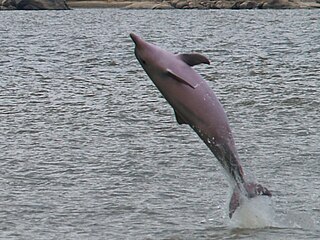
The tucuxi, alternatively known in Peru bufeo gris or bufeo negro, is a species of freshwater dolphin found in the rivers of the Amazon basin. The word tucuxi is derived from the Tupi language word tuchuchi-ana, and has now been adopted as the species' common name. Despite being found in geographic locations similar to those of 'true' river dolphins such as the boto, the tucuxi is not closely related to them genetically. Instead, it is classed in the oceanic dolphin family (Delphinidae).

Hevea is a genus of flowering plants in the spurge family, Euphorbiaceae, with about ten members. It is also one of many names used commercially for the wood of the most economically important rubber tree, H. brasiliensis. The genus is native to tropical South America but is widely cultivated in other tropical countries and naturalized in several of them. It was first described in 1775.
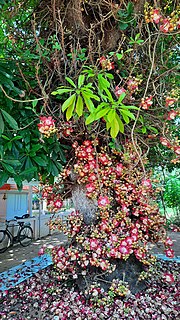
Couroupita guianensis, known by a variety of common names including cannonball tree, is a deciduous tree in the flowering plant family Lecythidaceae. It is native to the tropical forests of Central and South America, and it is cultivated in many other tropical areas throughout the world because of its beautiful, fragrant flowers and large, interesting fruits. Fruits are brownish grey. There are medicinal uses for many parts of Couroupita guianensis, and the tree has cultural and religious significance in India.

Clitoria is a genus of mainly tropical and subtropical, insect-pollinated flowering pea vines.
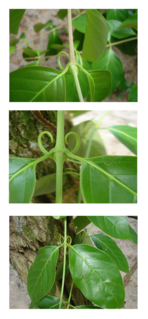
Uncaria tomentosa is a woody vine found in the tropical jungles of South and Central America. It is known as cat's claw or uña de gato in Spanish because of its claw-shaped thorns. The plant root bark is used in herbalism for a variety of ailments, and is sold as a dietary supplement.

Centrosema, the butterfly peas, is a genus of American vines in the legume family (Fabaceae). Species include:

Clitoria ternatea, commonly known as Asian pigeonwings, bluebellvine, blue pea, butterfly pea, cordofan pea and Darwin pea, is a plant species belonging to the family Fabaceae.

Barbieria is a genus of flowering plants in the legume family, Fabaceae.

The dolphin genus Sotalia is considered to have two member species with the classification of Sotalia guianensis as a distinct species from Sotalia fluviatilis in 2007. This was a result of recent morphometric analyses, as well as mitochondrial DNA analysis.

Uncaria guianensis, the cat's claw, is a plant species in the genus Uncaria found in the Amazon biome. Other names for the plant include uña de gato, Paraguayo and vincaria.
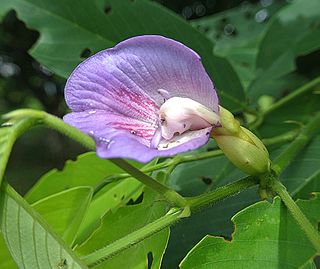
Clitoria fairchildiana, the sombreiro, is a flowering plant species in the genus Clitoria found in Campina Grande, Brazil.
Acrocercops clitoriella is a moth of the family Gracillariidae. It is known from Cuba.
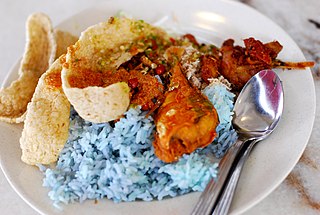
Nasi kerabu is a Malaysian cuisine rice dish, a type of nasi ulam, in which blue-colored rice is eaten with dried fish or fried chicken, crackers, pickles and other salads. The blue color of the rice comes from the petals of Clitoria ternatea (butterfly-pea) flowers (bunga telang), which are used as a natural food coloring in cooking it. The rice can also be cooked with plain white rice or rice cooked using turmeric. It is often eaten with solok lada and is also eaten with fried keropok.

Clitoria mariana, is a perennial forb.

Carapa guianensis is a species of tree in the family Meliaceae, also known by the common names andiroba or crabwood.

The Guiana dolphin, also known as the estuarine dolphin or costero, is a dolphin found in the coastal waters to the north and east of South America, and east of Central America. It is a member of the oceanic dolphin family (Delphinidae). It can live in both saltwater and freshwater.

Butterfly pea flower tea, commonly known as Blue Tea, is a caffeine-free herbal tea, or tisane, beverage made from a decoction or infusion of the flower petals or even whole flower of the Clitoria ternatea plant. Clitoria ternatea is also known as butterfly pea, blue pea, Aprajita, Cordofan pea, Blue Tea Flowers or Asian pigeonwings.

Clitoria falcata is a plant of the genus Clitoria native to South and Central America.

Myrcia guianensis (pedra-ume-caá) is a species of the flowering plant family Myrtaceae. It is found in South America.

Stylosanthes guianensis, the stylo, is a species of flowering plant in the family Fabaceae. It is native to the New World Tropics and Subtropics, and has been introduced to Puerto Rico, the Windward Islands, Trinidad and Tobago, most of Sub‑Saharan Africa, Madagascar, Mauritius, Réunion, Rodrigues, the Indian Subcontinent, Sri Lanka, Thailand, southeast China, Hainan, Taiwan, New Guinea, Queensland, New Caledonia, and the Cook Islands. An important forage and fodder species, its palatability to livestock increases as the plant matures, making it an unusual, and valuable, deferred feed. It has high genetic diversity between and among its named varieties.


















